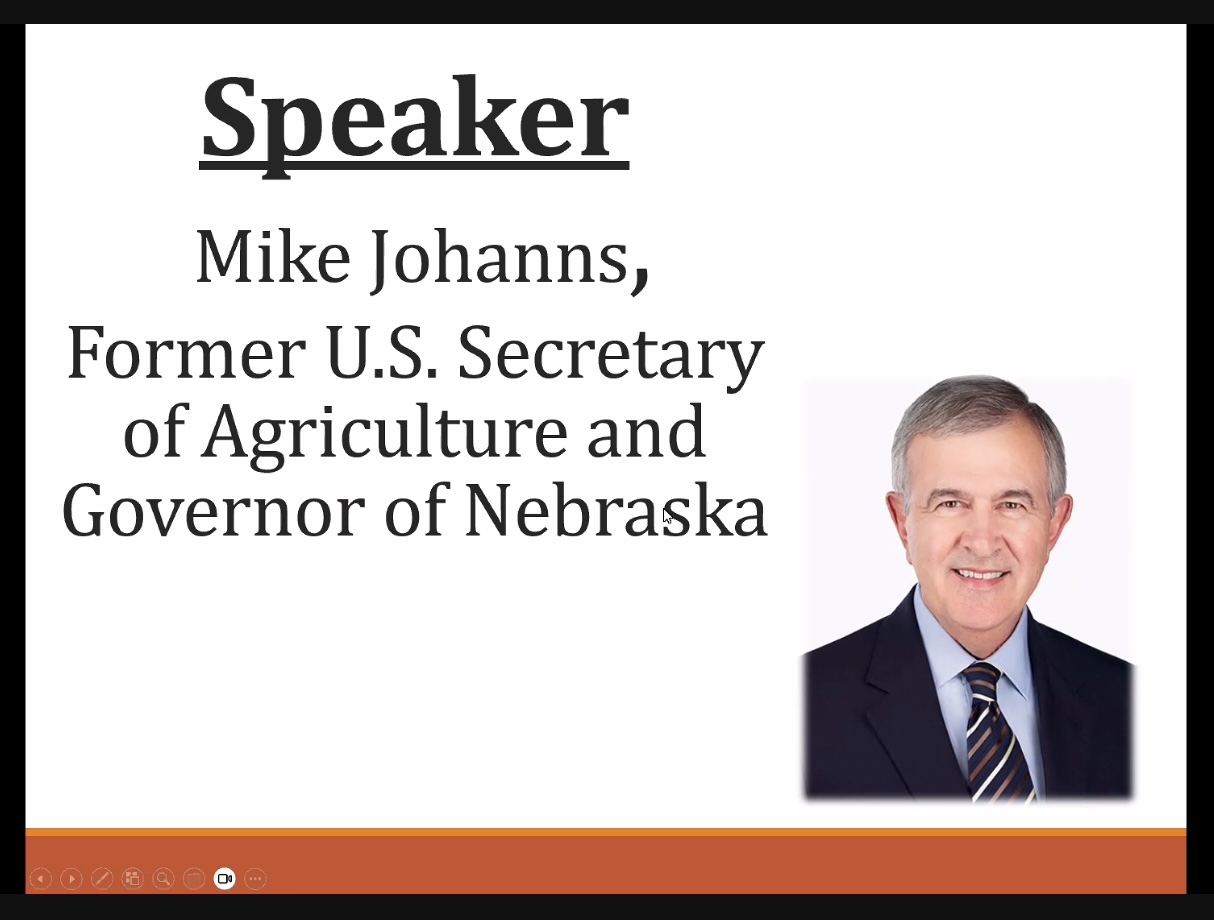By Kylene Scott
Former U.S. Secretary of Agriculture and former Nebraska governor Mike Johanns gave his take on the upcoming farm bill and what kind of effect it could have on livestock producers in a recent webinar was hosted by the Colorado Livestock Association.
Johanns said the farm bill is near and dear to his heart, as well as the livestock business.
“We all need to eat every day and we need to figure out how to do that the best way, most efficient way possible, because that world population continues to grow,” he said.
Writers
He thinks every farm bill discussion has to start with who actually writes the farm bill. Sen. Debbie Stabenow, the chair of the Senate Agriculture Committee, is the first to come to mind for him.
“She was chair when I was there in the Senate. Very, very capable person. Understands the farm bill,” he said. “She’s been down this road before.”
Next is Sen. John Boozman of Arkansas and he too knows his way around the farm bill, according to Johanns. On the “House side of the equation,” Johanns said he’s been very impressed with the chairman of the House Ag Committee, Glenn “GT” Thompson.
“He knows what he’s doing. He handles himself well,” he said.
With the House being Republican-led and the Senate Democratic-led, it’s setting up for some debate, Johanns believes. Ranking House member David Scott—everything Johanns has read about him says he pays attention to agriculture and his heart is in the Supplemental Nutrition Assistance Program.
Johanns believes this farm bill will be the first trillion-dollar bill—$1,463,000,000,000. Of that, $1.223 trillion or 84% is for nutrition. Conservation is at the $60-billion mark.
Policy predictions
Johanns said when President Donald Trump was in office, he got some additional funding out to Midwest row crop producers to the tune of $25 billion. Later there was a COVID rescue plan at $30 billion, more nutrition spending at $60 billion. About $17 billion was set aside for conservation and geared toward climate change with the Inflation Reduction Act. By the time it reached disaster assistance $15 billion was earmarked for it.
“That money by and large is still there and available, although the USDA is working to get that money out into the countryside,” he said. “Many on the Senate side especially are saying to the chair, Debbie Stabenow, let’s use that money for the farm bill. It will make our job a lot easier because right now they’re scrambling to figure out how to come up with this money.”
But so far Johanns said Stabenow hasn’t budged since they worked hard to get that money in the Inflation Reduction Act. The real political battle ground will likely be for SNAP. Work requirements will likely come out of the House, and Johanns doesn’t see that happening.
He sees climate change programs getting debated and thinks Republicans will look at those and not want conservation programs or other programs tied to climate change initiatives. Democrats are on the other side of the issue, with nutrition advocates wanting no cuts to their budget.
“You see the leadership in both the House and the Senate saying the same thing. We need a bipartisan farm bill,” Johanns said. “Now to you and I that sounds great—Republicans, Democrats joining arms working together to get a farm bill passed, president signs that everybody’s happy. But that’s going to be hard to accomplish.”
Johanns believes the Senate side is going to be more bipartisan simply because of the nature of the Senate. There will be 60 votes needed to pass in the Senate, while the House needs a majority vote. If they agree to cut SNAP and cut whatever else they want, Johanns thinks they can get it done.
The new Speaker of the House Mike Johnson is also saying it’ll get done in November, and Johanns believes that’s way too ambitious.
Climate change and livestock
The first issue Johanns sees coming out of the farm bill is the conservation programs getting tied up with climate change.
“Generally people want a voluntary conservation program that they can choose to participate in or not choose to participate in. Tying it up with a lot of requirements and regulations and hurdles to jump over is not well received,” Johanns said.
Johanns said the Environmental Quality Incentives Program from the Natural Resources Conservation Service is probably the most popular conservation program out there.
“I’m going to go out on a limb here and say even with tight budget issues, you could see more funding for EQIP,” he said. “I just think conservation pulls a lot of people in that support the whole concept.”
Johanns said the idea of crop insurance and other types of insurance for various ag products has been well accepted in the House and Senate.
Disaster programs are important to many producers as disaster happens and there’s no way to really plan for it—bad weather in the winter, extreme heat in the summer, drought, whatever it is. The Livestock Indemnity Program and Livestock Forage Program are two key ones for livestock producers.
“There’s been talk about a permanent disaster program for livestock, where a certain amount of money would be set aside. I don’t think that will happen,” Johanns said. “I just think money’s too tight.”
Kylene Scott can be reached at 620-227-1804 or [email protected].
Johanns’ Top 10
Mike Johanns had his top ten items he thinks will happen in the farm bill
1. Commodity title—unchanged with possible improvement in reference prices.
2. Conservation title—best chance of funding.
3. Minor climate approaches in the conservation title.
4. Crop insurance will continue to be a major safety net with improvements.
5. Nutrition will be fully funded with some improvements.
6. All other programs like rural development will be status quo.
7. Guard rails on Commodity Credit spending.
8. Regenerative agriculture won’t go far.
9. Sugar program is losing support.
10. Permanent disaster program for livestock won’t happen.




